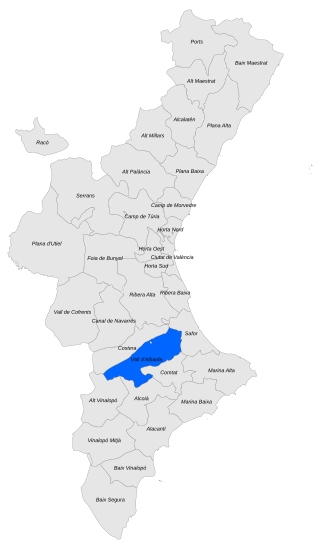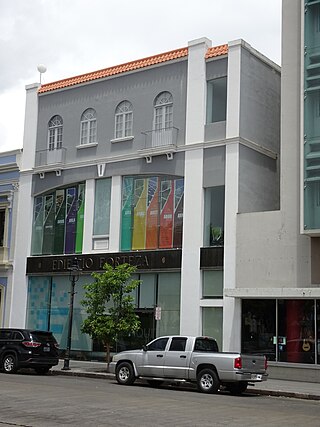
Elche (, Spanish:[ˈeltʃe]; Valencian: Elx,, , Valencian:[ˈɛʎtʃ] is a city and municipality of Spain, belonging to the province of Alicante, in the Valencian Community. According to 2024's data, Elche has a population of 234.8K inhabitants, making it the third most populated municipality in the region and the 20th largest Spanish municipality. It is part of the comarca of Baix Vinalopó.

Villena is a city in Spain, in the Valencian Community. It is located at the northwest part of Alicante, and borders to the west with Castilla-La Mancha and Murcia, to the north with the province of Valencia and to the east and south with the province of Alicante. It is the capital of the comarca of the Alto Vinalopó. The municipality has an area of 345.6 km² and a population of 34,144 inhabitants as of INE 2023.

Moros y Cristianos or Moros i Cristians, literally in English Moors and Christians, is a set of festival activities which are celebrated in many towns and cities of Spain, mainly in the southern Valencian Community. According to popular tradition the festivals commemorate the battles, combats and fights between Moors and Christians during the period known as Reconquista. There are also festivals of Moros y Cristianos in Spanish America.

Cocentaina is a locality and municipality in the comarca of Comtat, in the province of Alicante, Spain. The village is located between the mountainous Serra de Mariola national park and the Serpis river. Cocentaina is conveniently situated for both road and mountain biking. Many of the roads are used for training by professional teams, and several roads have been used by the Vuelta a España.

Vall d'Albaida is a comarca in the province of Valencia, Valencian Community, Spain.

Agres is a town and municipality in the comarca of Comtat, in the province of Alicante, Valencian Community, Spain.

Benimarfull is a municipality in the comarca of Comtat in the Valencian Community, Spain, just 14.5 kilometers from the town of Alcoy.

Penàguila is a municipality in the comarca of Alcoià, Alicante, Valencia, Spain.

The Pontifical Catholic University of Puerto Rico School of Architecture is an institution of higher learning granting degrees in the field of architecture. It is located in the Ponce Historic Zone, across from Plaza Las Delicias. It was established in 2009. Together with the School of Law, it is one of two semi-autonomous professional colleges of the Pontifical Catholic University of Puerto Rico (PCUPR) in the city of Ponce, Puerto Rico. In 2010, the school won an award from the Southern Puerto Rico Chamber of Commerce for Valor del Año en Educacion. The school is accredited by the National Architectural Accrediting Board (NAAB). It has a teaching staff of 40 and a student body of 300. The current dean of the school is Luis Badillo Lozano.

The Route of the Valencian classics,, is a cultural route through the lands of the great classical writers of the Valencian literature of the Valencian Golden Age: Ausiàs March, Joanot Martorell and Joan Roís de Corella, the three related to the court of the Duke Alfonso of Aragon and Foix, "the Old".

The Barxell Castle, located in the municipality of Alcoy, Alicante, Spain, is a 13th-century medieval building which stands on a rocky mound in the middle of a pine forest. It is next to the CV-795 road, between Alcoy and Banyeres de Mariola. It is located in the rural place of Barxell at 800 metres altitude. It is very close to the "Solanetes" which had a small population in the Muslim era.

The Palace of the Counts of Cocentaina, located in the municipality of Cocentaina, Alicante, Spain, is a 14th-century medieval building. This building originated as an old fortress with four halls and four towers on donjons crowned by merlons.

Valencian Gothic is an architectural style. It occurred under the Kingdom of Valencia between the 13th and 15th centuries, which places it at the end of the European Gothic period and at the beginning of the Renaissance. The term "Valencian Gothic" is confined to the Kingdom of Valencia and its area of influence, which has its own characteristics.

The castle of Banyeres (Alicante), Valencian Community (Spain), is an Almohad fortress built in the 13th century, which is situated on the tossal de l'Àguila (Valencian), English: 'Hill of the Eagle', in the geographical center of Banyeres, with an elevation of 830 meters above the sea level.
Timoteo Briet Montaud was a Spanish architect, one of the main architects of the Art Nouveau in Alcoy and the Valencian Art Nouveau.

Vicente Juan Pascual Pastor was a spanish architect, one of the main architects of the Art Nouveau in Alcoy and the Valencian Art Nouveau.

Art Nouveau in Alcoy, as one of the main focuses of the Valencian Art Nouveau, is the historiographic denomination given to an art and literature movement associated with the Art Nouveau in Alcoy (Alicante), Valencian Community, in Spain.

Valencian Art Nouveau is the historiographic denomination given to an art and literature movement associated with the Art Nouveau in the Valencian Community, in Spain.

The Casa del Pavo is a private building at 15 Sant Nicolau Street, in the city center of Alcoy (Alicante), Valencian Community, Spain. It is one of the main works of the Art Nouveau in Alcoy.


















